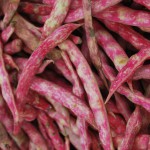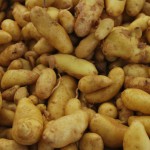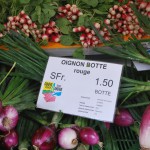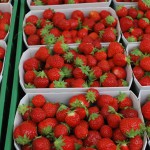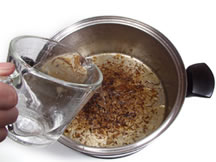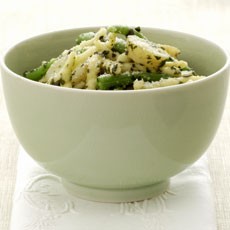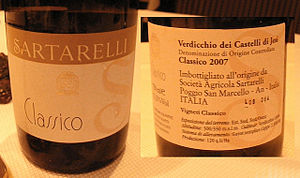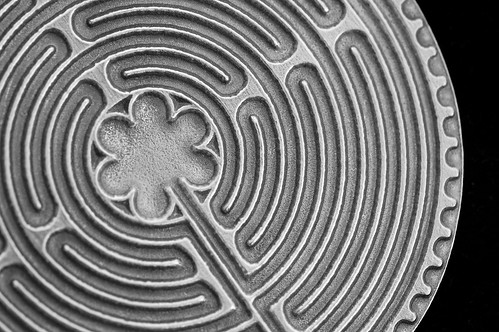 Summertime: Best Time to Start a Diet
Summertime: Best Time to Start a Diet
by Jonell Galloway
Summertime is diet time: an approach to changing your eating habits

Summertime is the best time to start changing your eating habits. Fruits and vegetables are tastier and cheaper in summer, so your tastebuds are satisfied, but with fewer calories and more fiber. You can take advantage of this time to start a lifestyle change that will not only help you lose weight, but hopefully change your way of eating for the rest of your life.
The Swiss seem to have understood some of the basic rules better than others, according to our 27 July 2009 article on the Swiss preference for fresh fruit and milk products.
Fill the kitchen with fruit
Start getting getting as much as possible of your sugar intake from fresh fruit.
Berries of all kinds are among the highest in fiber, and can be used in a variety of ways. In the Lake Geneva region, we have the good fortune of having berries from May and sometimes until late October or the beginning of November. If you want to nibble on something, you can just pop a handful in your mouth.
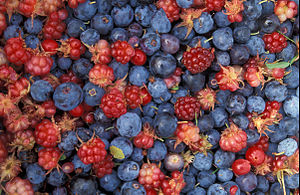
Cherries are also easy to just pop in your mouth when you want to nibble on something.
According to WebMD, tomatoes and peppers of all colors are both in the fruit family. They are rich in Vitamin A, Vitamin C, and lycopene, and low in calories. Munch on them to prevent snacking on processed foods.
Fruit is also full of water, so it makes you feel full, without eating any fat or carbohydrates.
There are endless combinations of fruit to throw into your smoothies or that can be mixed with fiber-filled granola, muesli or oats, along with some plain, sugar-free yogurt.
Make it a goal to eat fruit in some new way every time you need a sugar fix. A bowl of berries or cherries can even replace a glass of red wine, from time to time, and your tastebuds might not even notice it.
Fill the kitchen and fridge with fresh local vegetables
Buying local ensures that vegetables are fresher and therefore more flavorful.
An emphasis should be put on vegetables that can be eaten raw, and that are easy to prepare. If you have a little hunger pang, gnaw on a baby carrot stick, or slice a sun-ripened tomato, and add salt and a trickle of olive oil. If you can get your hands on some sun-ripened cherry tomatoes, you can pop them in your mouth like potato chips.

Make a big batch of gazpacho. It keeps for a few days and the high water content makes you feel full. It is also full of fiber and vitamins.
In the Lake Geneva region, we are blessed with a plethora of wild greens. In farmers markets, you can choose your own and make your own mesclun, or mixed greens, or buy the farmers’ own mixes , which vary from one producer to another. This wide variety lets you make a different kind of salad every day. The varieties are endless. But one warning about salads: the bad fats and calories are in the dressing, so try and make your own dressings, using good oils, yogurt, tahini, crushed tomatoes, etc.
The fact that summer vegetables are full of flavor will help you get in the habit of munching on vegetables instead of fat-filled snacks like chips and sausages.
Fill the fridge with plain yogurt and cottage cheese
Yogurt is full of iodine, calcium and phosphorous, and loads of other nutrients. According to The World’s Healthiest Foods, the Journal of the American Dietetic Association found low-fat, calcium-rich foods such as yogurt, which has the same fat content as the milk in your region (this varies from place to place, but hovers around 3.8% in the Lake Geneva region), to have a negative correlation with body fat. They encourage parents to accustom children to incorporate it into their diet in light of growing problems of obesity in children.

The 11 January 2005 issue of International Journal of Obesity found that obese adolescents who eat more than 3 yogurts a day in conjunction with a lower-calorie diet and an increase in physical activity lost 22% more than adolescents in a control group which only cut back on calories and had a lower calcium intake. Increased calcium intake can also help reduce weight, in particular abdominal fat.
Yogurt is also a source of low-fat protein, just like beans and cottage cheese. Both yogurt and cottage cheese open the door to endless combinations of fruit. The old-fashioned Mayo clinic diet of cottage cheese and a peach is not all that bad if your peach is ripe and juicy. Cottage cheese can also be doctored with herbs, to make it a savory dish.
Start getting your protein from low-fat sources
Gradually start replacing your sources of protein with yogurt, cottage cheese, eggs, beans, or soy-based products. Try making your smoothies with soy milk from time to time. Quark has more fat than the other options, but is still a low-fat source of protein as long as cream has not been added to it (read the label and fat content).
The more fiber the better
The more fiber-filled food you eat, the fuller you will feel. Over the long run, you will eat less fatty food.
More fiber helps you cut down on carbohydrates, and start decreasing their intake in your diet.
Water, water, water: never enough
Fiber soaks up water, making your tummy feel full. In summer, you need more water anyway, so it’s a good time to get in the habit of drinking your eight glasses of water per day.
Take another look at the food pyramid and the USFDA guidelines for healthy eating
The old food pyramid.
The US Food and Drug Administration is full of good advice about how to intelligently read food labels and make your calories count. Print out the pyramid and tape it onto your kitchen bulletin board or refrigerator door. Print out the food guidance and diet articles, and study them from time to time.

MyPlate replaces the old U.S. food pyramid
Unfortunately, their new food pyramid that came out earlier this year is totally color-coded and has no words because it is intended to be interactive, so I’m showing you the old one. Disabled World has added excellent explanations to the new one (it might be better to print theirs).
Eat 5 to 6 mini-meals instead of 3 large meals per day
Dr. Sue Cunningham from the University of Tennessee Health Science Center in the U.S. says that the human body is meant to be fed every 4 to 5 hours. Eating 2 or 3 mini-meals, consisting of healthy options, and 3 regular meals, in smaller portions, is therefore an ideal way to lose weight.
Continue eating out, but change your approach
When eating out, avoid ordering dishes with pastry, cream, and butter. Give preference to dishes containing lots of vegetables. Don’t hesitate to ask the server what is served with your dishes, and don’t hesitate to ask for side orders of vegetables and salads, even if they’re not listed on the menu. Skip the French fries and chips. Ask if you can replace them with salad or another vegetable. The more vegetables and salad, the merrier.
If you really can’t pass up dessert, try and choose fruit-based puddings, or homemade sorbets made with seasonal fruit. Don’t hesitate to ask if desserts are served with cream, whether they’re really sweet or rich, or any other question that might help you maintain your healthy ways. If you ask nicely and explain why you’re asking, servers rarely mind giving you advice about which desserts are healthier than others.
Cut down on carbohydrates
Winter vegetables tend to be higher in carbohydrates, so this approach to eating should by definition cut down your carbohydrate intake. Just remember to continue along the same lines once winter vegetables start again, and keep the level of carbohydrates in your diet low.
Give preference to the farmers market
The farmers market is a great way to give emotional support to these new eating habits. Take your camera along, and glory in the beauty of all the summer colors and beautifully stacked fruit and vegetables. Take your children along, and use the occasion to teach them why it’s better to eat fruit than artificially-flavored candy and show them the glories of summer as if it were an art show.
Change your supermarket buying habits
You might want to put a copy of the articles you’ve printed out in your pocket before going to the supermarket. That way you can read the labels on everything you buy and consult your list if you’re not sure whether an ingredient is good or bad. Sometimes just reading the label will scare you away from foods that are bad for you.

Don’t even go to the danger zones in the supermarket: chips, traditional savory cocktail accompaniments, sausage, frozen pizzas, cakes, cookies and biscuits, candy, or anything else that might be on the bad list, just waiting to tempt you.
It’s probably not advisable to take your children to the supermarket with you if you’re trying to make a true lifestyle change. They risk leading you down the candy aisle.
Avoid processed foods containing bad fats and needless additions of sugar.
If you find reading labels tedious, it’s better to stick to unprocessed foods and buy as much as possible at the farmers market or in the fresh food department of the supermarket.
Give preference to good fats
Good fats include monosaturated fats, contained in nuts and avocadoes and in canola (huile de colza) and olive oils. Polyunsaturated fats are found in fish such as salmon and fish oil, as well as in corn, soy, safflower oil and sunflower oil (huile de tournesol). Omega 3 falls into this category.

Photo courtesy of Adventures in Health
Bad fats include saturated fats, found in all animal products, as well as in some oils, such as coconut (huile de coco) and palm oil (huile de palme), which are to be strictly avoided. Both these oils are a big favorite of processed food manufacturers.
Trans fats do not even occur in nature. Scientists invented them to make processed foods last longer. They are the favorite fat used in fast food, and are used to make most margarine.
Check out healthier products such as soy milk and different types of sugar-free, low-fat, milk-based products such as the fresh cheese Serra, found in the Lake Geneva region, and delicious when eaten with berries, or cottage cheese, good with peaches or apricots. Herb-flavored cottage cheese is now available in almost all supermarkets. Traditional cheeses with higher fat contents are not advisable.

Stock up on olive oil. Try to replace butter with olive oil as often as possible. For example, it’s wonderful on toast with a clove of garlic run over it, and it makes a tasty fried egg. If you want a more neutral taste, give preference to canola oil.
Gradually, you will realize that you are cutting down on bad fats — the trans fatty acids and saturated fats — and fat in general. You will gradually train your stomach not to crave foods full of bad fats and carbohydrates
Towards a new way of eating
This is not a diet in the traditional sense of the word. It is just a way of improving your eating habits so that you are healthier and feel better about yourself. No matter what your current eating habits, you will almost surely lose a little weight if you follow these guidelines. In addition, you’ll feel better about yourself, because you’ll feel you’re taking good care of yourself.
If your BMI is significantly higher than the average for your age and sex, it is best to consult a doctor.
Please note that these are guidelines for healthy eating. I am NOT a dietitian. Medical advice is required for serious weight problems.
Continue Reading…






















